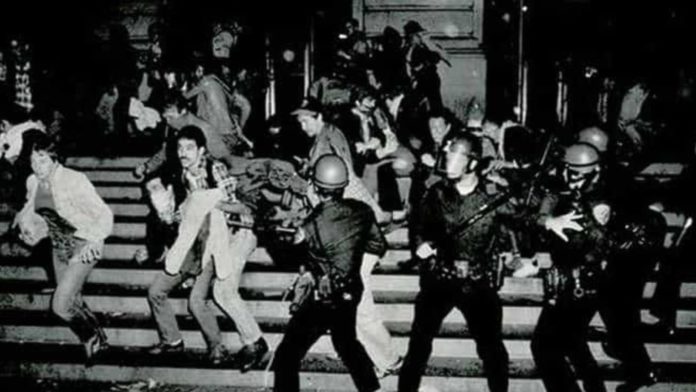
‘Pride’ has become a global phenomena. Replete with colours and joy, the event, celebrating LGBTQ+ social acceptance, struggle and legal rights, stirs up a joyous image. And over 50 years from the first Pride ever – which was actually a riot – Mark Segal, who witnessed the scenes in Stonewall, New York, conjures the same ‘pure joy’ from the day.
Segal, in an earlier interview to the AFP, had no trouble recalling the early hours of June 28, 1969 — when the first in a series of violent protests by members of New York’s gay community erupted outside the now-legendary Stonewall Inn. In the wee hours of that Saturday, a hot night in Manhattan, a group of lesbians, drag queens, transgender people and young, gay men including Segal decided to stand up to police abuse.
They cornered a group of officers who had earlier raided the Stonewall Inn, a seedy, popular gay bar in Greenwich Village — the second such raid that week alone.
“It was the first time our community imprisoned the police, who had always imprisoned us before,” Segal told AFP, looking back on what would become a seminal event in the gay rights movement.
Segal was only 18 years old at the time and had just moved to New York from Philadelphia. He recalls the “pure joy” of that night vividly, the report states. “The passion was so overwhelming,” he said, adding that no one understood the historic significance of what was happening at the time.
In the late 1960s, homosexuality was still considered a mental illness, and gay sex was illegal in all but Illinois. Millions of gay and lesbian Americans lived in secret for fear of losing their jobs or homes if their true identities were revealed. Some were openly assaulted, while others were detained for inappropriate behaviour.
The Stonewall Inn on Christopher Street was run by the Mafia of New York, and it sold alcohol without a permit – but famously watered it down. The bar was famous for its massive jukebox and for being the only gay bar that allowed dancing, even slow dancing. In short, it was a safe haven for a community that had grown accustomed to being treated with hostility.
The Final Moments
When Boyce, the son of a New York taxi driver, arrived at the Stonewall Inn with a friend that Friday night, the bar was packed and the raid was in full swing, the report by AFP says. The crowd was around 200 people, including those thrown out of the bar by police and those who had gathered outside.
Boyce claimed to have seen a police paddy waggon before “this very brutal cop was pushing some queen and she kicked him in the shoulder with her heel.”
“He climbed back into the truck. You heard a banging, a moaning, bone and flesh, sting of metal,” he recalled, and the cop ordered the crowd to disperse. The audience was enraged.
“There was a movement to do what he said as always,” Boyce told AFP.
“But we didn’t do what he said — we started walking towards him.”
After police raided the bar, a diverse crowd of hundreds of gay men, bisexuals, lesbians, and transgender people refused to leave quietly. They confronted the officers, hurling coins, bottles, invective, and other objects at them. Some defied arrest and fought with officers, who took cover inside the bar until riot police arrived. For several more nights, there were protests, defiance, and arrests.
There had been some organised gay protests and spontaneous fights between LGBTQ people and police in the United States. However, Stonewall was a watershed moment. It sparked a sustained burst of organising that altered the tone and volume of LGBTQ activism, as well as how some people perceived themselves in a society that had relegated many to the shadows and shame.
‘Never Saw Gay as Political Slogan Before’
The words “Support Gay Power” were scrawled on the Stonewall’s boarded-up windows the night after the raid, and they blew Dale Mitchell’s mind.
“I had never seen ‘gay’ as part of a political slogan before, let alone associated with the word ‘power,’” he recalls.
Mitchell, who was 20 at the time, didn’t feel so powerful. He’d had to drop out of college after breaking up with his family over his sexual orientation, and he was living in a drug-infested rooming house with an older man who was mortified by the Stonewall rebellion the night before, the Associated Press reported.
Mitchell, on the other hand, was struck by it, as well as the crowd that gathered the night after the raid, calling for gay power as another tense standoff with police developed.
He would become Indiana University’s first openly gay student senator two years later, telling a student newspaper that gay people were “showing that our power is real.” In 2-19, he was named grand marshal of the Boston Pride Parade for his work advocating for LGBT senior citizens through the organisation SAGE and other organisations.
A New Visitor Centre to Honour the Place
A visitor center dedicated to telling the story of the LGBTQ rights movement will open next door to the Stonewall Inn, according to an announcement in June by the nonprofit that will manage the center in partnership with the National Park Service.
The groundbreaking for the Stonewall National Monument Visitor Center in New York City’s Greenwich Village neighborhood took place in the month, with the center expected to open in summer 2024, said Ann Marie Gothard, board president of Pride Live, an LGBTQ advocacy organization.
“The opening of the Stonewall National Monument Visitor Center is a remarkable moment in the history of Stonewall,” Gothard said. “We honor all those who came before us, most especially the queer people fighting for equality at the Stonewall riots.”
This year’s Pride Month in New York kicked off June 1 with the dedication of a rainbow flag at the Stonewall monument, the first rainbow flag to fly daily on federal land. The ceremony followed a yearslong battle by activists to ensure that a rainbow flag would fly on federal land at the Stonewall monument.
The 7.7-acre monument includes the park known Christopher Park, across from the Stonewall, but does not include the Stonewall itself, which is still a bar. The visitor center will be housed in the storefront adjoining the Stonewall, which was part of the bar in 1969.
Gothard said that when the national monument was created in 2016 “it became clear that a visitor center was needed.”
The Stonewall visitor center will offer in-person and virtual tours, lectures and visual arts displays dedicated to the history of the LGBTQ rights movement, Gothard said.
With inputs from Associated Press, AFP
Read all the Latest News, Breaking News, watch Top Videos and Live TV here.







